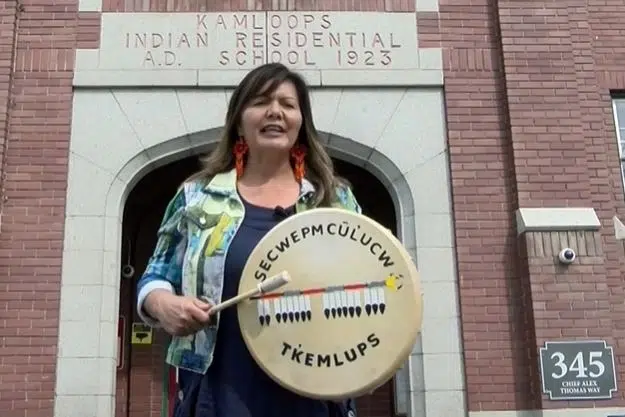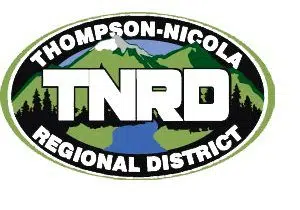
Tk'emlúps Kukpi7 Rosanne Casimir outside the Kamloops Indian Residential School building. (Photo via Tk’emlúps te Secwepemc)
The Chief of Tk’emlúps te Secwepemc says it is unfortunate that residential school denialists tried to dig up the suspected graves of children at the site of the former Kamloops Indian Residential School.
Speaking to Radio NL since those details were first made public Friday, Kukpi7 Rosanne Casimir said the band has had to increase security following its “painful and traumatic” May 2021 announcement that it had discovered what is believed to be 215 unmarked graves.
“Many people dealt with it in different ways and brought people to different levels of curiosity. I know that some people started to want to trespass and come over here to either take pictures or post videos just out of curiosity,” Casimir said. “At some point, in the very beginning, security had to put a halt to someone who had a shovel in hand. [I’m] not too sure of the full story but that was what was shared. Since then, we had to have 24-hour security.”
“Our existing security expressed the concern of increased traffic coming [to the site] at all odd hours so we had to support [them] in ensuring that it is not increasing and adding so much to their [workload] because they already have a lot of areas that they have to take care of.”
The interim report by Special Interlocutor, Kimberly Murray, also raised concerns about increasing attacks from denialists who challenge communities when they announce the discovery of possible unmarked graves.
Murray said those attacks take place by email, phone, social media, op-eds, and, at times, through in-person confrontations, with Casimir quoted as saying the “toxicity of denialism on social media needs more attention.”
“Everything from racial to discriminatory comments,” Casimir told Radio NL. “You know, just a lack of information that people had [about the Residential School System].
“We looked at how can we work to provide information to educate individuals while we work with the different levels of government, when we work with our Special Interlocutor, trying to field that path moving forward that is going to continue to honour and support and protect all those that have been impacted from the Residential Schools.”
In her report, Murray, said “urgent consideration” needs to be given to legal mechanisms as a way for Canada to combat residential school denialism. She also said that while some media outlets were “ethical” and “fact-based,” Tk’emlúps te Secwepemc also had to deal with “many uninvited visitors, including media and denialists, who did not always respect this Sacred site.”
“Some breached cultural protocols, taking photos and video recordings of the burial site area without consent. Many communities have had to adopt security measures to keep trespassers off the search sites,” the report reads, in an apparent reference to Casimir’s comments that Tk’emlúps had to bring in more security.
According to Murray’s report, Casimir concluded that Tk’emlúps’ experiences with the media and denialism highlighted the need for other communities to maintain strict control of investigation sites and the information provided to the media.
Casimir also recommended that other First Nations undertaking similar work around unmarked burial sites create a communications strategy, while also ensuring that there are mental health supports in place for survivors, families, and community members.
“We have put in some protocols with groups and with media when it comes to footage. We don’t want any pictures or anything that would disrespect the site. That was established with our legal [department],” Casimir told Radio NL. “We also had put in place no drone footage in that area. I know we do drone requests down at the Arbour and other areas but not over the Sacred Site.”
“We have definitely made that off limits.”
Next steps
Casimir previously told Radio NL that Chief and Council at Tk’emlúps te Secwepemc will consult with band members before deciding what the next steps to survey the grounds would be.
She also pledged to keep band members informed about the progress and findings at the site.
“I am actually not too sure right at this time,” Casimir said, when asked if there were updates about when or if potential archeological work could take place. “I do know that work has taken place but I’m just allowing the technical experts to be doing what they need to be doing and I too will be looking forward for an update sometime in the near future.”
“I know that there is still a lot of work that needs to get done, and we are progressing.”
– With files from Brett Mineer and The Canadian Press














